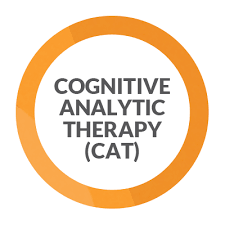COGNITIVE ANALYTICAL THERAPY (CAT)
What is Cognitive Analytic Therapy (CAT)?
CAT is a therapeutic approach that combines psychodynamic explorative principles and the CBT skills in dealing with clients presenting problems. It is therefore a medium term therapy; usually occurring over 8 - 24 sessions (a hybrid of short-term CBT and Long-term Psychodynamics). Therapy involves trying to understand how we currently cope with emotional distress and difficulties in relationships with others.
Ryle and Kerr (2002) suggested that CAT takes three important understandings from psychoanalysis:
- the relation of early development to psychological structures;
- recognition of the linkage between psychological distress and patterns of relationships derived from early experience;
- an understanding of how relational patterns are repeated in and may be modified through the therapeutic relationship.
The theoretical model of CAT is the procedural sequence model (PSM). This allows description of how aims are pursued and may be frustrated. It is used to describe repetitive circular (stuck) patterns of activity.
Problematic patterns in CAT are described as:
- Dilemmas: which limit the possibilities for action or relationships to polarized choices. For example: ‘Either I get what I want and feel childish and guilty, or I do not get what I want and feel frustrated and angry.’
- Traps: represent the maintenance of negative beliefs by the way they generate forms of behaviour that lead to consequences which appear to confirm the beliefs. For example: a pattern of trying to please.
- Snags: describe where appropriate goals are abandoned or sabotaged because it is believed that their achievement would be dangerous to the self or disallowed by others. For example: ‘I sabotage good things as if I do not deserve them.’
Stages of CAT in Individual Therapy
The stages of CAT in individual therapy are:
- Stage 1: Assess suitability for CAT by excluding active psychosis and substance misuse; discuss the nature and duration of treatment.
- Stage 2: Explores client history, and uses the patient–therapist relationship as well as the Psychotherapy File and Personality Structure Questionnaire in order to create a reformulation of the patient’s difficulties. Patient and therapist collaborate to create a sequential diagrammatic reformulation.
- Stage 3: The therapist encourages the patient to use diaries and self-monitoring to identify problem procedures. The reformulation is used to understand developments in the therapeutic relationship, and to assimilate memories and feelings accessed as result of the work. Awareness of the end of therapy is maintained.
- Stage 4: Therapist and patient reflect upon the implications of ending therapy.
Who may benefit from CAT?
CAT is used for a range of difficulties such as:
- Depression,
- Anxiety and
- Relationship problems.
- Eating disorders
- Personality disorders.
- People who have become stuck in unhelpful patterns of behaviour or relationship.
You need to be motivated to engage in therapy and prepared to some extent to explore your childhood experience
What to expect
CAT is an active therapy. You will normally be expected to keep a diary and to do some homework between sessions. There will be some filling in of questionnaires at the beginning of therapy.
The therapist
- will help you to recognise patterns of behaviour and to understand where these have come from.
- will do this by paying attention to how you are in the sessions, past events in your life and how you reacted to them, and the way that you are now in your everyday life.
- will sum up the main patterns and the targets of therapy
- will also use diagrams to describe the main patterns of behaviour, thinking and feelings that you wish to change.
You and the therapist
- will jointly agree upon the main targets for the therapy.
- will look for other patterns of coping.
Over time you
- will try to change the way you react, replacing the old patterns.






